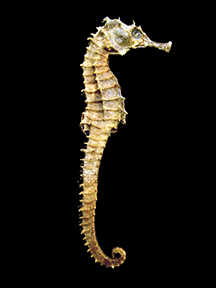Stop and think a moment about seahorse tails. Try to visualize one in your mind. Seahorse tails are prehensile, of course, and it’s easy to imagine a seahorse hanging on to whatever vegetation is handy But if you’ve ever looked closely at one, you may have noted that that the plates that form the seahorse tail are square instead of streamlined. New research by Porter and colleagues published in the July 3, 2015, issue of Science magazine attempts to explain “why the seahorse tail is square.” The research article is accompanied by a thoughtful and accessible commentary by Wake Forest Biology Professor Miriam Ashley-Ross, who explains what it all might mean for bioinspired engineering. In particular, she notes that When living organisms deviate from the norm, there’s usually a good biomechanical reason: a clue to some specific problem that needs to be solved. Professor Ashley-Ross’ commentary has already been quoted by the LA Times. Professor Ashley-Ross teaches comparative physiology, comparative anatomy, and, of course, biomechanics courses for undergraduates at Wake Forest.
Find more like this: Uncategorized
